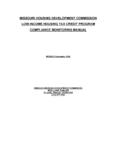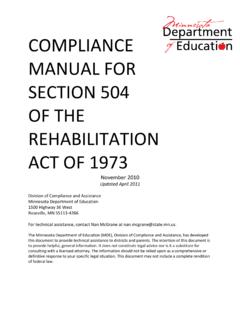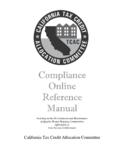Transcription of State of Connecticut Department of Housing …
1 State of Connecticut Department of Housing HOME compliance Manual i TABLE OF CONTENTS Part I: Introduction 1 A. Owner s Responsibilities B. HOME Mixed Income Housing C. Factors Influencing Management Performance of Rental Housing D. DOH's Monitoring Responsibilities Part II: HOME Rules Rental Property 7 A. Project Occupancy Restrictions B. Determining Family Income C. Families Whose Income Rises Above the Limit D. Project Rent Requirements E. Components of Gross Rent F. Utility Allowance G. Leases H. Property Standards I. Term of Restricted Use - Restrictive Covenant Filed of the Land Records J. Sale of Property After Placement in Service Part III: HOME Rules - Home Ownership Property 15 A. Occupancy Restrictions B. Determining Family Income C. Purchase & After Rehab Price Restrictions D. Term of Restrictive Use - Restrictive Covenant Filed of the Land Records E. Sale of Property F.
2 Recapture Restrictions Part IV: General Requirements Rental & Home Ownership Property 19 A. compliance With Fair Housing and Equal Opportunity Laws B. On-going Affirmative Marketing C. On-going Insurance Requirements Part V: Reporting Requirements Rental & Home Ownership Property 24 A. Rental Housing B. Ownership Housing Part VI: Program Monitoring & compliance Remedies 25 A. Program Monitoring Guidelines B. Findings, Deficiencies & Concerns C. Program Noncompliance ii APPENDICIES I. HOME Project Transition Report to DOH II. compliance Chart III. Sample Forms for Application, Certification and Re-Certification IV. Sample Utility Allowance Forms V. Sample Eligibility and Ineligibility Form Letters VI. Sample Grievance and Appeal Policy VII. Sample HQS Property Inspection Form VIII. HOME Annual Report Form IX. Annual Rental Project Certification Report Form X. Homeowner s Annual Affidavit XI.
3 Audit Supplement - HOME - Administrative Fund 1 HOME compliance Monitoring - After Project Completion Part I: Introduction A. Owner s Responsibilities In accordance with HOME Rule, the Owner of a project receiving a HOME allocation is required, by acceptance of the allocation, to: 1. Manage the project in accordance with the HOME Rule and any agreements reached with DOH for the duration of the compliance period or mortgage term, whichever is longer, and certify to this fact; 2. Certify that the property is being managed in accordance with all applicable federal, State and local fair Housing laws; 3. Maintain a project file for at least five years after the last year of the compliance period (maximum total of 26 years); and 4. Assume liability for any instances of noncompliance and the correction of such deficiencies. Prior to a project being placed-in-service, a Owner s responsibilities, include but are not limited to insuring that they have: 1.
4 Implemented a successful Affirmative Fair Housing Marketing Plan; 2. Determined the eligible household income of each prospective tenant/resident, based on the HUD Section 8 rules for calculating annual gross income; 3. Obtained verification of income sources of all adult household members age 18 and older, as well as benefits paid on behalf of minors in the household; 4. Received third-party verification of all income. All items that affect the eligibility of an applicant must be verified and be 90 days current to the move-in date. Owners may extend verification an additional 30 days by documented oral contact (signed, dated, and indicating source); 5. Selected potential tenants/residents in accordance with an approved Resident or Tenant Selection Plan. Income Limits: HUD publishes median income information for Connecticut , which is broken down into local areas, such as county or metropolitan areas.
5 These limits are published by HUD on an annual basis. Initial Income Certification: To determine whether an applicant is eligible, Owners must compare the applicant anticipated annual (gross) income for the next 12 months to the income limits for the appropriate household size. The eligible income from all adult members of the household is counted when determining the annual income for a household. There are specific requirements regarding the sources of income that must be included and excluded when determining annual income. 2 Rent Requirements: The HOME Program places limits on the rent that can be charged for assisted units. It also mandates that at initial occupancy 20% of the units in a project have rents based on 50% of median income; the remaining units must have rents based on 60% of area median income, adjusted for family size. When a unit is vacated, the next available unit that is comparable in term of size and features must be leased to a household with the same income eligibility and rent restrictions as the previous household.
6 Any exceptions to this requirement are contained in the contract for financial assistance. Rent Increase Procedure: Prior to the DOH contract for financial assistance, a market analysis is completed to establish appropriate market rents for the project. The contract for financial assistance requires a restriction of rents that are delineated for the project. During the first year of operation, project rents may not exceed the rent contained in the approved operating budget, which is incorporated into the contract for financial assistance. Other compliance Requirements Prior to Placed In Service: 1. Within two weeks following the loan or grant closing but prior to the start of construction, the Project Manager meets with the developer to restate the responsibilities and obligations of the developer during the development of a HOME project. Representatives from Audit and Asset Management and Affirmative Action should also attend this meeting.
7 The issues discussed shall include, but are not limited to the following: a) Davis Bacon Wage requirements b) Section 3 Hiring requirements c) EEO requirements d) Property Acquisition and Relocation requirements e) Procurement requirements f) Draw down procedures and requirements g) Construction closeout and monitoring 2. Pre-Occupancy Meeting Six months prior to expected project completion, the Project manager shall conduct a special Pre-Occupancy monitoring visit to discuss the tenant selection process, including all Affirmative Fair Housing Marketing requirements. DOH s experience has shown that a Pre-Occupancy meeting among the DOH staff, management agent personnel, particularly on-site staff responsible for tenant selection, and Owners, if applicable, is beneficial to all of the participants. The meeting affords the management agent and field staff the opportunity to have the DOH s Field, Affirmative Action and Asset Management staff available to discuss the HOME Program requirements, on-going compliance and reporting issues, among other matters.
8 3. Project Completion Visit The Project manager shall notify the Asset Management Division in writing of the expected date of initial occupancy. The Project Manager and the developer should be prepared to complete the HUD Project Completion Form, which will be submitted to the Deputy Director or his designee. A copy of the Project Completion Form should be provided to the sponsor prior to the visit so that required 3 financial and tenant characteristics data can be collected. During the visit the Project Manager must: a) Ensure that 100% of tenant files are reviewed by Audit & Asset Management b) provide the sponsor with a cost certification form to be completed and returned to the Project manger c) ensure that the project is inspected by the Infrastructure & Real Estate Division 4. Annual Project Certification Report - The Annual Rental Project Certification and other year end status reports are to be completed as of December 31 of each year and submitted to the DOH by March 1; and 5.
9 IPA audit of project/development cost is not required, however, a Owner must submit a Cost Certification Form acceptable to DOH. Record-Keeping Requirements: The following documents must be retained by the Owner in each resident file: Rental Ownership Rental Application Form; Application Form; Resident Certification Form; Resident Certification Form; Third-Party Income Verification; Third-Party Income Verification; Verification of Utilities Form; Sales/Purchase Agreement; and Residential Lease; and Lead-Based Paint Brochure. Lead-Based Paint Brochure. The following documents must be retained at the Owner s sales/rental office: Annual Operating Budgets (rental only); Affirmative Fair Housing Marketing Plan (AFHMP); Section 3 Plan; Resident or Tenant Selection Policy and Procedures; Waiting List; and Utility Data Documentation (rental only). Record Retention: All record keeping items as listed above must be retained for FIVE YEARS after the year to which such records apply.
10 All records must be available upon request for DOH staff review. In accordance with HOME Program regulations, the Owner's record-keeping requirements include, but are not limited to: 1. The total number of residential rental units in the project, including the number of bedrooms and the square footage of each unit; 2. The number and percentage of extremely low, low and moderate-income renters in the Housing development; 3. The number of disabled families or persons assisted; 4. The number of homeless families or persons assisted; 5. The racial and ethic status of families or persons assisted; 6. The rent charged on each unit in the development, including the utility allowance; 4 7. The number of occupants in each unit; 8. The vacancy history of the HOME assisted units and when and to whom the next available unit was rented; 9. Income certifications for each tenant/resident and sufficient documentation to support the certification; and applicable, a brief narrative of the character and use of the non-residential portion of the building(s) within the development.















